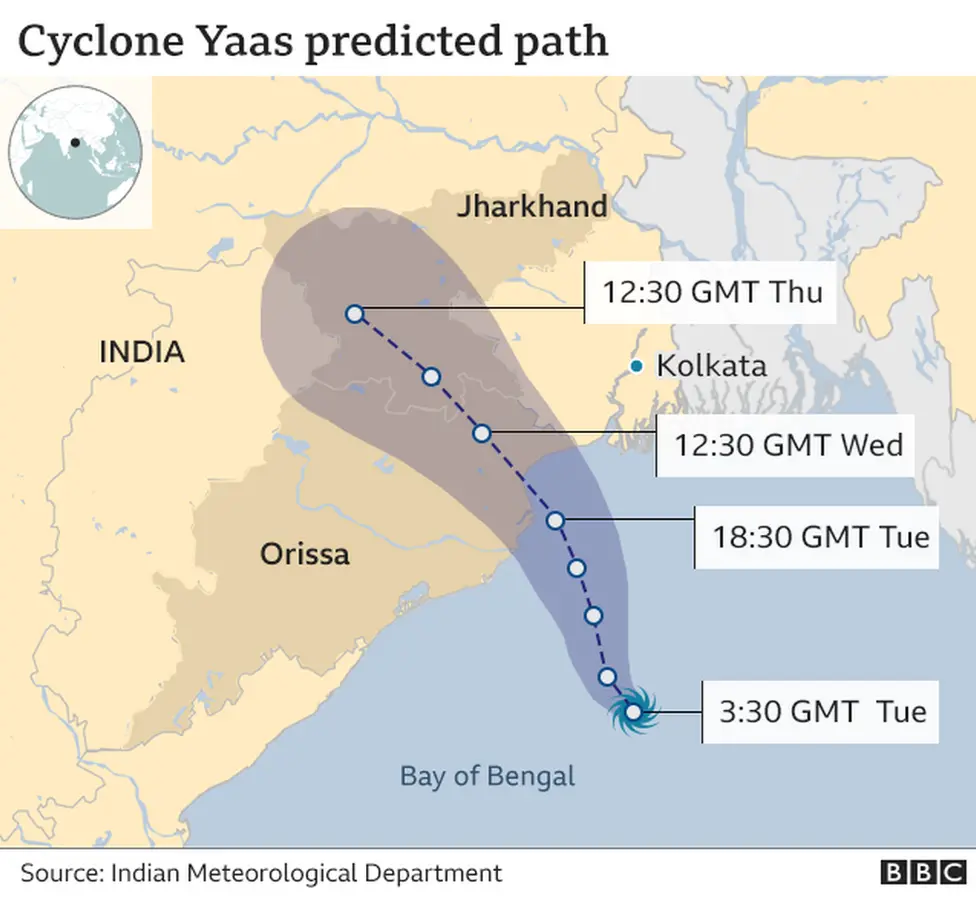Cyclone Yaas: Severe storm lashes India and Bangladesh
A powerful cyclone has torn into eastern India, with reports suggesting it has killed several people.
Cyclone Yaas, which intensified into a "very severe cyclonic storm", hit the states of West Bengal and Orissa - also known as Odisha - on Wednesday, as well as lashing southern Bangladesh.
This is the second cyclone to hit the country in a week, after Cyclone Tauktae killed more than 150 people.
It comes as India is already struggling to deal with its Covid-19 outbreak.
Yaas lashed coastal areas with ferocious wind and rain as it made landfall in India, damaging homes and bringing waves that swamped towns. More than one million people were evacuated in the country as the storm approached.
In its latest update, the India Meteorological Department tweeted that the cyclone had sustained winds of 70-80km/h (43-50mph) and with gusts of up to 90km/h. It said the storm is "likely to move further northwestwards and weaken gradually" in the next three hours.
Allow X content?

West Bengal chief minister Mamata Banerjee said some 20,000 homes were damaged in the state, with the town of Digha "swamped" by four-metre-high (13ft) waves. One person was killed there after being dragged out to sea while another died after their home collapsed, she reportedly said.
In Orissa, there are reports that two people were killed by uprooted trees. A relief official said they were investigating the incidents.
Nearly 1,200 rescue shelters have been sanitised in line with Covid-19 safety norms, and health teams have been deployed there - but there are worries that it will be difficult to maintain social distancing protocols as more than a million people are evacuated to shelters, according to news agency ANI.
 EPA
EPA Reuters
ReutersTidal surges also flooded coastal areas of Bangladesh, stranding thousands of people.
According to an official there quoted by the Associated Press news agency, more than 20 villages in the southern Patuakhali district were submerged after waters washed away two river embankments, and at least 15,000 people had gone to cyclone shelters.
Officials told AFP news agency that one man was killed in Bangladesh by a falling tree as waters swept over defences.
India's states of Andhra Pradesh, Jharkhand and Tamil Nadu on the east coast are also likely to be affected, with more than 50 rescue teams sent to them.
Airports in Bhubaneswar in Orissa, and Kolkata in West Bengal have suspended all operations until Wednesday evening.


Cyclone Yaas comes at a time when India has been battling a deadly second wave of Covid-19 infections, and healthcare systems are already overworked.
Crematoriums, graveyards and hospitals were already functioning at full capacity with the rapid increase in cases and deaths, though there is a relative fall in fresh infections now, according to official data.
 Reuters
ReutersWhat makes the bay so dangerous?
In March last year, Cyclone Amphan, said to be the first super cyclone to form in the Bay of Bengal since 1999, devastated West Bengal state, killing hundreds.
In 2019, Cyclone Fani, which formed in the Bay of Bengal, hit Orissa, causing immense damage to life and property.
"[The] north coast of the Bay of Bengal is more prone to catastrophic surges than anywhere on Earth," Bob Henson, meteorologist and writer with Weather Underground had earlier told the BBC.
He said that the Bay of Bengal is a "textbook example" of the worst kind of places for storm surges to develop - shallow, concave bays where water is pushed by the strong winds of a tropical cyclone. This gets concentrated as the storm moves up the bay.
Meteorologists say that high sea temperatures in the "warm" Bay of Bengal are also a major reason for strong cyclones.
